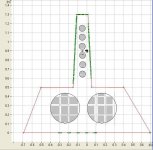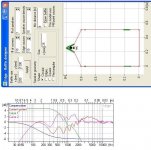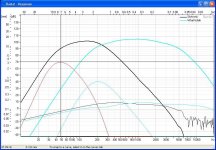Hi Folks,
I'm working on a set of open baffle speakers consisting of a pair of 15" subs , 6 mids in line configuration and a single tweeter per side. I've be playing around with these of and on for a while and will soon be building properly.
I've uploaded some pic including the edge response and the actual design. I'd appreciate it if someone could give me some advice on them. Am i on the right track or are there some points on which im way off.
Not there will be actively crossed and i should be able to even out the 2db bump in the mids with a band pass filter (i think thats the right term?)
Here are some pics and the xl baffle info.
15" skytronic qts 0.92
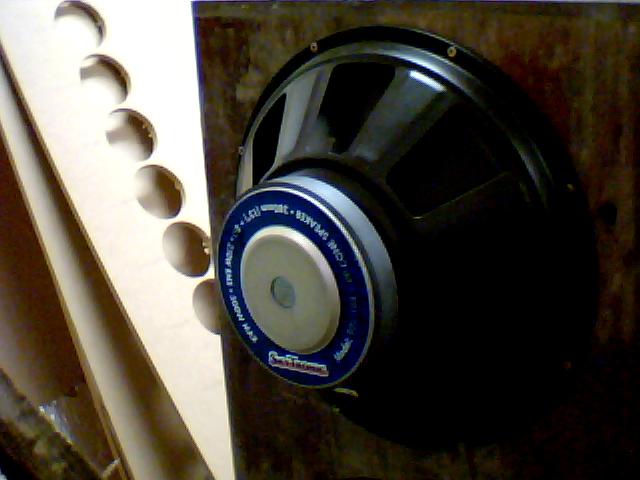
4" Wharfedale qts 0.52 picture with 0.25" wharfedale tweeter note the removable magnet on the wharfedale - this allows a certain altering of t/s parameters.

Edge response woofers (2) mid (6) tweeter (1) Physical design note the tweeter is slightly offset i may have to roll off the outer drivers at a lower frequency by i'm aiming for between 3 and 5 khz i'm think it might be possible to use a small horn to improve tweeter response i's fs is 1360 khz
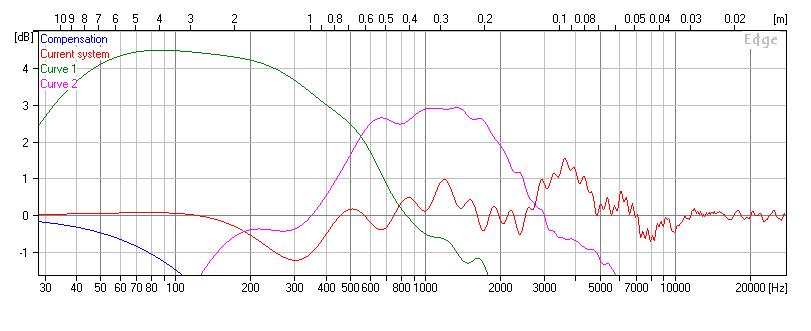
ob design - My Photo Gallery
SUB MID
Driver Resonant Frequency (Fs - Hz): 30.00 90.00
Driver Electrical Q (Qes): 1.19 0.63
Driver Mechanical Q (Qms): 4.11 2.84
Driver Equiv Volume (Vas - liter): 178.00 3.20
Thermal Power Limit (P - VA): 250.00 75.00
DC Resistance (Re - Ohm): 5.80 4.80
Pk-to-Pk Excursion (Xmax - mm): 6.00 3.00
Effective Cone Dia. (D - mm): 320.00 75.00
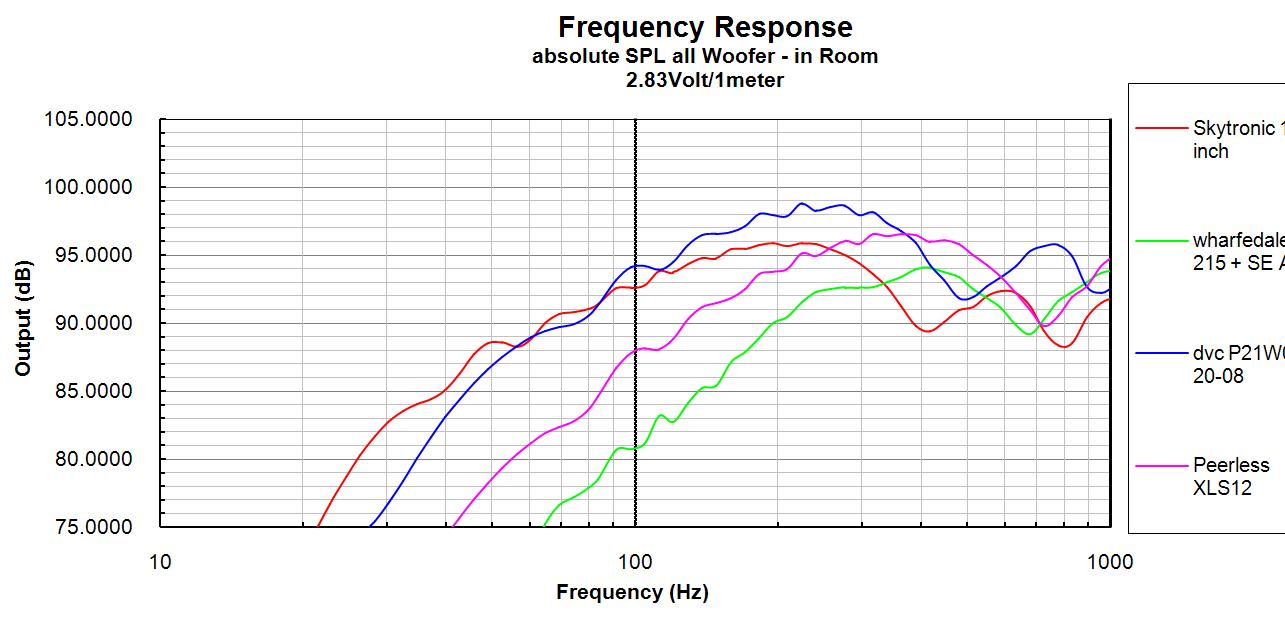
sorry about pics - dodgy webcam used and some of my link might be a bit weird.
I'm working on a set of open baffle speakers consisting of a pair of 15" subs , 6 mids in line configuration and a single tweeter per side. I've be playing around with these of and on for a while and will soon be building properly.
I've uploaded some pic including the edge response and the actual design. I'd appreciate it if someone could give me some advice on them. Am i on the right track or are there some points on which im way off.
Not there will be actively crossed and i should be able to even out the 2db bump in the mids with a band pass filter (i think thats the right term?)
Here are some pics and the xl baffle info.
15" skytronic qts 0.92

4" Wharfedale qts 0.52 picture with 0.25" wharfedale tweeter note the removable magnet on the wharfedale - this allows a certain altering of t/s parameters.

Edge response woofers (2) mid (6) tweeter (1) Physical design note the tweeter is slightly offset i may have to roll off the outer drivers at a lower frequency by i'm aiming for between 3 and 5 khz i'm think it might be possible to use a small horn to improve tweeter response i's fs is 1360 khz
ob design - My Photo Gallery
SUB MID
Driver Resonant Frequency (Fs - Hz): 30.00 90.00
Driver Electrical Q (Qes): 1.19 0.63
Driver Mechanical Q (Qms): 4.11 2.84
Driver Equiv Volume (Vas - liter): 178.00 3.20
Thermal Power Limit (P - VA): 250.00 75.00
DC Resistance (Re - Ohm): 5.80 4.80
Pk-to-Pk Excursion (Xmax - mm): 6.00 3.00
Effective Cone Dia. (D - mm): 320.00 75.00
sorry about pics - dodgy webcam used and some of my link might be a bit weird.
Attachments
Hi,
The only thing I can say is thats the most bizzare OB design i've ever seen.
The narrow mid section and line array will not work well at all and you will
eventually rebuild them to something like a MTM at most with a decent
baffle width, and vertically stack the bass units for the tweeter height.
rgds, sreten.
Paul Carmody's DIY Audio Projects - undefinition
Zaph|Audio
RJB Audio Projects
Speaker Design Works
HTGuide Forum - A Guide to HTguide.com Completed Speaker Designs.
Humble Homemade Hifi
Click below to go to
Quarter Wavelength Loudspeaker Design
The Frugal-Horns Site -- High Performance, Low Cost DIY Horn Designs
Linkwitz Lab - Loudspeaker Design
Music and Design
The only thing I can say is thats the most bizzare OB design i've ever seen.
The narrow mid section and line array will not work well at all and you will
eventually rebuild them to something like a MTM at most with a decent
baffle width, and vertically stack the bass units for the tweeter height.
rgds, sreten.
Paul Carmody's DIY Audio Projects - undefinition
Zaph|Audio
RJB Audio Projects
Speaker Design Works
HTGuide Forum - A Guide to HTguide.com Completed Speaker Designs.
Humble Homemade Hifi
Click below to go to
Quarter Wavelength Loudspeaker Design
The Frugal-Horns Site -- High Performance, Low Cost DIY Horn Designs
Linkwitz Lab - Loudspeaker Design
Music and Design
Hmm, well, I think its doable. A few things though.
You didn't state where your XO points are. You are doing a fully passive XO? Do you have decent ability to sim the crossover, including the actual frequency response's of the respective drivers, on their baffles? Passives XO's like this are relatively difficult.
I would seriously caution you against relying on the edge and your woofer sim to come anywhere near the actual responses of your drivers on baffles.
Your line array will make sound, and may be acceptable - but it won't have a normal dipole or line array response. If I had to use all those drivers, I would try grouping them close together. You will have issues with any sound radiated with a wavelength half the distance of the furthest apart drivers.
But most of all, have fun!
You didn't state where your XO points are. You are doing a fully passive XO? Do you have decent ability to sim the crossover, including the actual frequency response's of the respective drivers, on their baffles? Passives XO's like this are relatively difficult.
I would seriously caution you against relying on the edge and your woofer sim to come anywhere near the actual responses of your drivers on baffles.
Your line array will make sound, and may be acceptable - but it won't have a normal dipole or line array response. If I had to use all those drivers, I would try grouping them close together. You will have issues with any sound radiated with a wavelength half the distance of the furthest apart drivers.
But most of all, have fun!
This reminds me one of my previous thought (not identical but very close) and I'm glad someone is trying to make it real 😀
http://www.diyaudio.com/forums/multi-way/162783-baffle-less-dipole-array.html
According to some OB line array builders (I don't remember the names, sorry), those lobing and interference etc sort of bad things are not so evident in real life while OTOH the benefit of arrays shines. So go for it and let us know how it goes.
The baffle holes have already been cut as seen in the picture, or I'd like to suggest naked drivers hung by wires😀
http://www.diyaudio.com/forums/multi-way/162783-baffle-less-dipole-array.html
According to some OB line array builders (I don't remember the names, sorry), those lobing and interference etc sort of bad things are not so evident in real life while OTOH the benefit of arrays shines. So go for it and let us know how it goes.
The baffle holes have already been cut as seen in the picture, or I'd like to suggest naked drivers hung by wires😀
Thanks for the replies folks.
i've tried a bit of remodelling and come up with the info below this is based on vertically stacking the woofers and using a single tweeter and single mid.
The response in edge doesn't look as clean as with the 6 mids.
This is all going to be actively crossed with woofers running from 40hz to 200hz, mid/s from 200 to 300 to 5 khz depending on response and sound quality and the tweeter up from there.
As it's active i can choose between 1,2,4 and 8th order linear phase crossovers on the computer along with time delays shelving filters for any baffle step correction etc.
not sure if vertical subs make any real difference at least in the basic design done with edge. 6 mids do seem to even out the response over using just one although crossover frequency may have to be in the 2khz range due to combing. Of course theres nothing to stop me rolling of the outer drivers at say 1.5khz and running the centres to 5khz.
Apart from combing issues that may arise there doesnt seem to be any real benefit from changing to this design apart from a more 'normal design' lower crossover or rolled off mids and a physically smaller speaker which i don't care about. I think i might have to try both designs and see which i prefer.
Please note that the graphs have suggested baffle step compensation included and the subs have had bass drop compensation added.
i've tried a bit of remodelling and come up with the info below this is based on vertically stacking the woofers and using a single tweeter and single mid.
The response in edge doesn't look as clean as with the 6 mids.
This is all going to be actively crossed with woofers running from 40hz to 200hz, mid/s from 200 to 300 to 5 khz depending on response and sound quality and the tweeter up from there.
As it's active i can choose between 1,2,4 and 8th order linear phase crossovers on the computer along with time delays shelving filters for any baffle step correction etc.
not sure if vertical subs make any real difference at least in the basic design done with edge. 6 mids do seem to even out the response over using just one although crossover frequency may have to be in the 2khz range due to combing. Of course theres nothing to stop me rolling of the outer drivers at say 1.5khz and running the centres to 5khz.
Apart from combing issues that may arise there doesnt seem to be any real benefit from changing to this design apart from a more 'normal design' lower crossover or rolled off mids and a physically smaller speaker which i don't care about. I think i might have to try both designs and see which i prefer.
Please note that the graphs have suggested baffle step compensation included and the subs have had bass drop compensation added.
Attachments
Please note that the graphs have suggested baffle step compensation
included and the subs have had bass drop compensation added.
Hi,
Your mid array will have baffle ripple and then baffle loss.
I cannot see how "baffle step compensation" is relevant.
rgds, sreten.
Streten,
Can you explain baffle ripple please not sure on that one. As for baffle step i added this as there is a rising response from 100hz up to around 1.5khz with a difference of 6db between 100hz and 1.5 khz by using baffle step compensation i guess i'm trying to tame the high midrange so it balances with the low midrange.
I should be able to get a fairly flat response across the mids by using compensation and dropping the high mids approx 2db.
Maybe i'm just way off with all of this?
Is it worth paying for a license for basta and modelling using it instead?
Can you explain baffle ripple please not sure on that one. As for baffle step i added this as there is a rising response from 100hz up to around 1.5khz with a difference of 6db between 100hz and 1.5 khz by using baffle step compensation i guess i'm trying to tame the high midrange so it balances with the low midrange.
I should be able to get a fairly flat response across the mids by using compensation and dropping the high mids approx 2db.
Maybe i'm just way off with all of this?
Is it worth paying for a license for basta and modelling using it instead?
It looks a bit - shall we say... DIFFERENT - but its not a bad idea, not at all! Narrow baffle is good for obtaining a good dipole radition pattern in the midrange. You might even consider dropping the mid baffle, and run the mid drivers nude.
Oublie,
Edge can only simulate the response of ONE driver SIZE on a specific baffle at a time. If you actually want to design and built anything, you urgently need a program which allows to consider real driver data and combinations of different drivers. Basta will do that or you might take a look at A_B_C_Dipole.
It is not only "worth paying for a license" - you will simply fail without it IMHO.
Rudolf
Edge can only simulate the response of ONE driver SIZE on a specific baffle at a time. If you actually want to design and built anything, you urgently need a program which allows to consider real driver data and combinations of different drivers. Basta will do that or you might take a look at A_B_C_Dipole.
It is not only "worth paying for a license" - you will simply fail without it IMHO.
Rudolf
Last edited:
Have just ordered a license for basta, looking forward to getting stuck in and seeing the results.
Streten,
Can you explain baffle ripple please not sure on that one. As for baffle step i added this as there is a rising response from 100hz up to around 1.5khz with a difference of 6db between 100hz and 1.5 khz by using baffle step compensation i guess i'm trying to tame the high midrange so it balances with the low midrange.
I should be able to get a fairly flat response across the mids by using compensation and dropping the high mids approx 2db.
Maybe i'm just way off with all of this?
Is it worth paying for a license for basta and modelling using it instead?
Hi,
As your mids are open baffle you will get open baffle roll off not BSC.
Your drivers will be miles down at 100Hz, not 6dB, BSC only applies
to enclosed boxes, not open baffle.
rgds, sreten.
http://www.quarter-wave.com/OBs/OB_Design.pdf
Jordan JX92S OB with a Goldwood GW-1858 Woofer in an H Frame Project
thanks very much for the advice guys.
500hz does seem quite high but ill give it a go on my test baffles and with basta to see what i get.
Just waiting for my serial number now.
if this doesnt play ball i'll probably just invest in a decent pair or 8 or 10" mids for ob but i'd like to give this option a shot.
500hz does seem quite high but ill give it a go on my test baffles and with basta to see what i get.
Just waiting for my serial number now.
if this doesnt play ball i'll probably just invest in a decent pair or 8 or 10" mids for ob but i'd like to give this option a shot.
Results are in
Got basta serial did a quick sim.
here are the results same baffle - proper driver specs
4m mic distance i.e. listening distance
open baffle set in box design,
voltage for half xmax of sub and 0.5mm for mid
high pass at 50hz 4th order and 200hz low pass for sub
high pass at 200hz 4th order and 5khz low pas for mids
looks too good to be true?
Got basta serial did a quick sim.
here are the results same baffle - proper driver specs
4m mic distance i.e. listening distance
open baffle set in box design,
voltage for half xmax of sub and 0.5mm for mid
high pass at 50hz 4th order and 200hz low pass for sub
high pass at 200hz 4th order and 5khz low pas for mids
looks too good to be true?
Attachments
Hi Oublie,
I'm not familiar enough with Basta to comment on your results, but I will say I'm a bit surprised by the tone of some of the comments posted by others. Is this idea really that odd compared to other things we have explored at diyaudio?
It also seems to me that being overly pedantic about baffle step compensation is hard to justify. BSC is just one example of an attempt to address directivity issues when designing a crossover. I've never understood why it has reached cult status while other directivity issues are less commonly discussed or addressed.
Oublie, one thing that did strike me, and that you might consider, is that the directivity of your bass system, midrange system, and treble system will be a bit inconsistent. You'll have something approaching a point source in the bass, a truncated line source in the midrange, and a point source for the treble (some of these will be dipole versions). As a result, if you get their on-axis responses to blend well at one listening distance and one listening angle, it will be significantly off at other distances and angles. There is a growing consensus that this causes problems. You might give some thought to the wavelength each driver, or collection of drivers, will be called upon to reproduce and then choose the dimension of your drivers, or driver systems, accordingly. Having everything act as point sources, or everything act as line sources, may yield a more satisfying result than some form of hybrid. Of course creating a true line source in the bass where the wavelengths become very large is a bit of a trick. "Fortunately" room resonances come to the rescue--or complicate the situation further--depending on how you look at it.
Keep at it!
Few
I'm not familiar enough with Basta to comment on your results, but I will say I'm a bit surprised by the tone of some of the comments posted by others. Is this idea really that odd compared to other things we have explored at diyaudio?
It also seems to me that being overly pedantic about baffle step compensation is hard to justify. BSC is just one example of an attempt to address directivity issues when designing a crossover. I've never understood why it has reached cult status while other directivity issues are less commonly discussed or addressed.
Oublie, one thing that did strike me, and that you might consider, is that the directivity of your bass system, midrange system, and treble system will be a bit inconsistent. You'll have something approaching a point source in the bass, a truncated line source in the midrange, and a point source for the treble (some of these will be dipole versions). As a result, if you get their on-axis responses to blend well at one listening distance and one listening angle, it will be significantly off at other distances and angles. There is a growing consensus that this causes problems. You might give some thought to the wavelength each driver, or collection of drivers, will be called upon to reproduce and then choose the dimension of your drivers, or driver systems, accordingly. Having everything act as point sources, or everything act as line sources, may yield a more satisfying result than some form of hybrid. Of course creating a true line source in the bass where the wavelengths become very large is a bit of a trick. "Fortunately" room resonances come to the rescue--or complicate the situation further--depending on how you look at it.
Keep at it!
Few
Few,
thanks for the advice and encouragement. I will have to have a really good play about with Basta before i start finalising my design as sreten i think pointed out i may end up just going mtm however, with the driver size and the ctc spacing i'm going to get combing from approx 1.8khz upward so using mids to augment 200hz to say 500hz and then crossing to mtm might be a possibility.
The only reason i'm doing it this way is that my woofers are not exactly world class 🙂 I bought 4 of these off ebay reasonably cheaply to use for what is my first ob project. A lot of projects i've read about seem to suggest crossing around 200 to 300 hz Nothing is ever final and since im using the computer for active crossovers i can change things at the drop of a hat.
So far the results in simulation aren't too dissapointing bu if things end up looking really bad i'll drop the mids and go for a single larger sized midrange.
thanks for the advice and encouragement. I will have to have a really good play about with Basta before i start finalising my design as sreten i think pointed out i may end up just going mtm however, with the driver size and the ctc spacing i'm going to get combing from approx 1.8khz upward so using mids to augment 200hz to say 500hz and then crossing to mtm might be a possibility.
The only reason i'm doing it this way is that my woofers are not exactly world class 🙂 I bought 4 of these off ebay reasonably cheaply to use for what is my first ob project. A lot of projects i've read about seem to suggest crossing around 200 to 300 hz Nothing is ever final and since im using the computer for active crossovers i can change things at the drop of a hat.
So far the results in simulation aren't too dissapointing bu if things end up looking really bad i'll drop the mids and go for a single larger sized midrange.
Hi Oublie,
It also seems to me that being overly pedantic about baffle step compensation is hard to justify.
Few
Hi,
Being pendantic about baffle loss is easy to justify, the mid arrangement
is now being "boxed", whats the point of the OB bass end ? not much.
rgds, sreten.
oublie - take a closer look at exactly what you are modelling in Edge. Those green points are the only points used to create the FR graph, most of your baffle shape is not being sampled. Any place on your baffle that does not have a green point is not considered in the model. The height of your baffle is not modeled at all, since there isn't a single green point on the bottom.
You have a complex baffle, so you need a high number of Edge Sources to model it accurately. With only 10, you are sampling once every 36 degrees. You should increase this to at least 100, higher if your computer can handle it, but don't do this just yet.
On the other hand, your Speaker Source Density is very high. Much too high in my opinion, to model such a small speaker relative to baffle size, causing the Edge to model the same points on your baffle many times over. You need to turn this down, otherwise your computer will take a very long time generating the FR.
Try this - first set your speaker source density to 2, then increase Edge Sources to 180. That samples about the same number of points on the baffle as your current model, but they will be much more spread out.
You have a complex baffle, so you need a high number of Edge Sources to model it accurately. With only 10, you are sampling once every 36 degrees. You should increase this to at least 100, higher if your computer can handle it, but don't do this just yet.
On the other hand, your Speaker Source Density is very high. Much too high in my opinion, to model such a small speaker relative to baffle size, causing the Edge to model the same points on your baffle many times over. You need to turn this down, otherwise your computer will take a very long time generating the FR.
Try this - first set your speaker source density to 2, then increase Edge Sources to 180. That samples about the same number of points on the baffle as your current model, but they will be much more spread out.
thank for the info owdi i've now moved on to using basta.
I've simmed a few different designs but i am still going back to my original.
it seem to offer the best option regarding midrange response even though as few quite rightly pointed out i am using varying speaker alignments.
Please note that i will be putting on a front and rear facing tweeter and this is completly open baffle no boxes.
the tweeters in question were used with the wharfedale 9.1 diamond speakers and cross at approximately 2.3 khz so i should be able to do likewise with these allowing me to remove most of the combing i may encounter.
As for the mids i've been running 12 per side in line array configuration open baffled for about a year ( i have 64 of them ) the baffle is only 15cm wide - great mids and maybe im lucky but i cant hear any comb effect with 12 in a row so hopefully ill be ok.
plan to build a rough prototype at the weekend ill try and get pics and possibly measurements.
I've simmed a few different designs but i am still going back to my original.
it seem to offer the best option regarding midrange response even though as few quite rightly pointed out i am using varying speaker alignments.
Please note that i will be putting on a front and rear facing tweeter and this is completly open baffle no boxes.
the tweeters in question were used with the wharfedale 9.1 diamond speakers and cross at approximately 2.3 khz so i should be able to do likewise with these allowing me to remove most of the combing i may encounter.
As for the mids i've been running 12 per side in line array configuration open baffled for about a year ( i have 64 of them ) the baffle is only 15cm wide - great mids and maybe im lucky but i cant hear any comb effect with 12 in a row so hopefully ill be ok.
plan to build a rough prototype at the weekend ill try and get pics and possibly measurements.
- Status
- Not open for further replies.
- Home
- Loudspeakers
- Multi-Way
- OB advice
